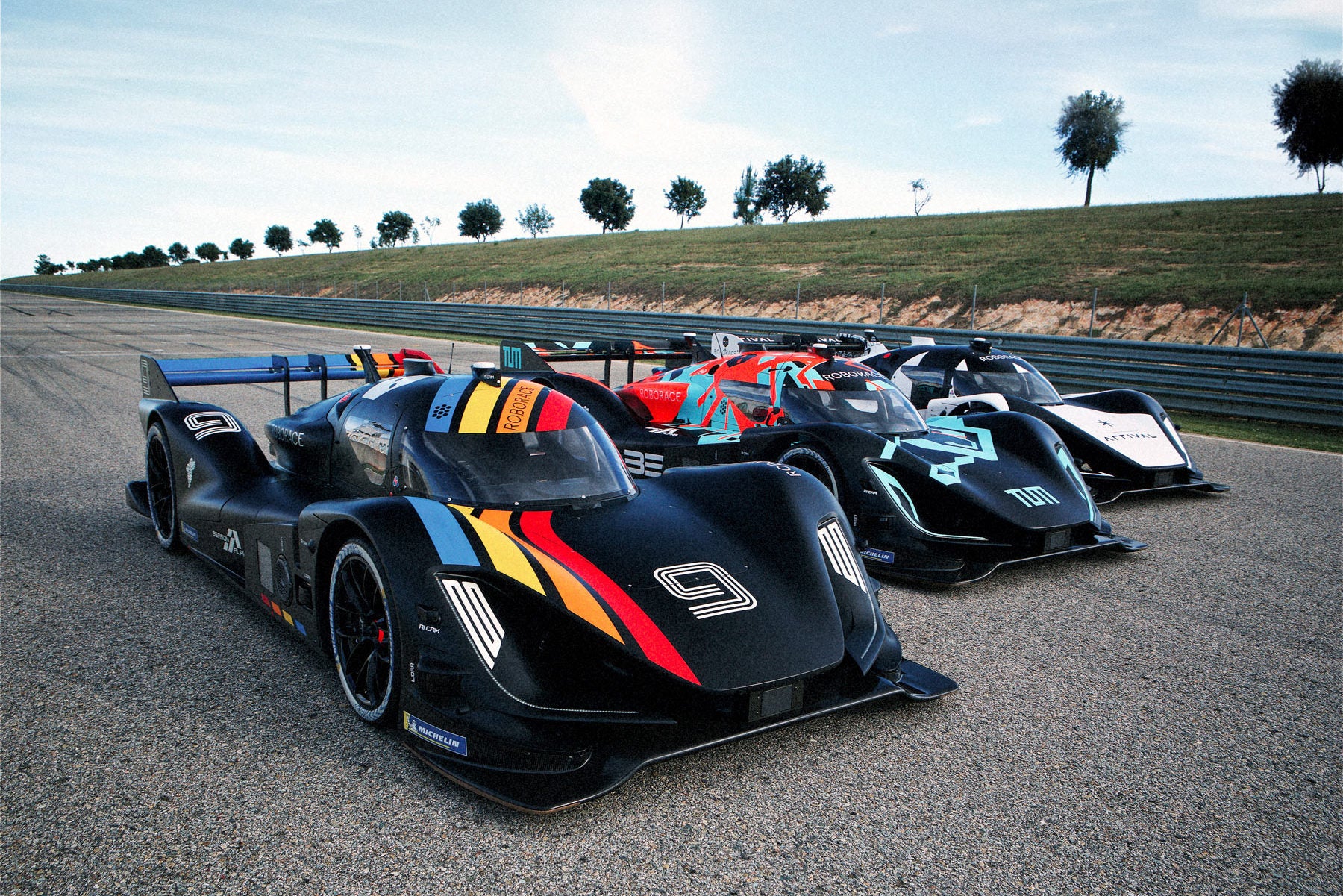
A new form of motor racing got underway this year, one in which the driver is optional. Roborace, a competition for human and artificial intelligence (AI) teams, is on a mission to push the limits of motorsports.
Roborace’s primary goals are to develop new forms of motorsport entertainment and explore the relationship between human and machine drivers, with the research from the sport trickling down into driverless cars for consumers.
Originally announced in 2014, Roborace launched its debut competition, Season Alpha, in April this year. Little is known about these races as they take place in private, with the sport still in its test season. There are three teams taking part in its inaugural season: Arrival, TUM and the University of Pisa.
At the heart of Roborace is the DevBot 2.0, a bespoke, all-electric car that is part-Batmobile, part-Tron Legacy. Covered in an array of sensors that feed environmental data into NVIDIA’s DRIVE platform – the brains of the car – the DevBot 2.0 and its predecessors have already racked up some impressive achievements.
In 2018, Roborace’s previous self-driving car was the first to run an autonomous car up the Goodwood’s Festival of Speed’s hill climb.
This year Roborace will return to the Festival of Speed to tackle the same run with the DevBot 2.0.
How well do you really know your competitors?
Access the most comprehensive Company Profiles on the market, powered by GlobalData. Save hours of research. Gain competitive edge.

Thank you!
Your download email will arrive shortly
Not ready to buy yet? Download a free sample
We are confident about the unique quality of our Company Profiles. However, we want you to make the most beneficial decision for your business, so we offer a free sample that you can download by submitting the below form
By GlobalDataAnd on the 6 June the DevBot 2.0 became the first autonomous car to complete the Shelsley Walsh Hill Climb – the oldest motorsport venue in the world.
Roborace, a testbed for driverless cars
For all the thrill and exhilaration of watching a futuristic car steer itself around bends at breakneck speeds, there are many exciting implications for how testing the technology could improve commercial driverless cars on the roads.
Motor racing has always been about pushing the limits of the vehicle and improving with each iteration. These improvements, whether in breaking or in seatbelts, have later found themselves in consumer cars.
Roborace is no different in this respect, but the focus is different: pushing intelligence, rather than the mechanics.
“In the past, it used to be high-stress from a mechanical perspective because you’re driving fast, the vibrations are a lot harder, the way you’re driving the car is harsh,” explains Roborace chief strategy officer Bryn Balcombe, who spoke with Verdict at NVIDIA’s GPU conference in San Jose in March.
“If you drive in a rally, for example, the environment is incredibly harsh. All of these things were mechanically based. What we’re doing in Roborace is setting intelligence-based challenges. This is all about ‘what’s the situation’, and can the AI driver deal with that situation and deal with it safely.”
As the DevBot 2.0 hurtles round the track at speeds of up to 190mph, navigating using LiDAR, ultrasonic sensors, AI cameras and GNSS positioning, the car is operating at a much higher level and under greater pressure than a commercial driverless car would on the road.
“Frame rates on cameras have to be higher, potentially,” says Balcombe. “It means your LiDAR needs to be longer range and update more frequently. It means using radar technology, developing algorithms that really harness the power of radar, which is kind of underdeveloped at the moment.”
And that’s what makes Roborace so suited as a testbed for driverless car technology: if the car can successfully navigate high-stress conditions at maximum speeds, it should – in theory – have no problem with taking you to work.
“If your car can actually make it that distance then, in theory, it’s going to be the most reliable car that’s on the road,” says Balcombe.
“Or if it’s the highest performance, it’s going to have the highest performance on the road. We’re at an era now where if it’s the most intelligent, it will be the most intelligent on the road.
“In reality, you’d never drive your car to the maximum limit. And it will be the same with intelligence – you’ll never actually use it to the maximum limit, until there’s an incident that needs to be avoided.”
Winning over public trust in autonomous vehicles
Driving on the road comes with a dangerous factor not present on empty test tracks – humans. More than 90% of all road accidents are caused by human error, a figure that proponents of driverless car technology say will drop dramatically when connected, and autonomous vehicles are making the decisions for us.
That same truth applies in traditional motorsports – it’s almost always the driver that makes a decision that leads to an accident.
“That goes away when you have AI driving software, because it’s the software that made the decision,” says Balcombe. “So then it’s a question of ‘well, who’s written the software?’ Because it’s their reputation on the line.”
However, public confidence in driverless cars remains low, something often attributed to isolated crashes in autonomous Uber and Tesla cars over the last couple of years.
Balcombe believes Roborace can help inspire public confidence in autonomous vehicles. But what if the DevBot 2.0, driving autonomously, were to crash in front of a packed crowd – as an earlier Roborace car did in Buenos Aires in 2017? Would that dent public confidence in autonomous vehicle technology?
Balcombe doesn’t think so – provided there is proper communication with the public about the level of risk the algorithms are working at.
“Let’s say [motorsport] is up at 95% risk, whereas on the road you want to be down at one or two per cent risk. And just being able to communicate that to the public is really important.”
“Motorsport has always been an environment where manufacturers can deploy new technologies in an R&D environment, but then also showcase those technologies to the public. And through that showcase, the public gains awareness. And from that awareness, they gain confidence in the brand.”
Not just driverless
Driverless technology is not Roborace’s only focus. The organisation is also exploring ways that technology can assist drivers both on and off the race track.
“Autonomy is just one type of deployment of AI,” says Balcombe. “You have to start looking at assisted, augmented and adapted as well. From a motorsport perspective, that’s what we’re trying to stimulate.”
On the roads, that could mean an ambulance using augmented driving to help drivers when on emergency calls.
Reinventing the (racing) wheel
Balcombe believes that Roborace has the potential to create motor races that are unlike anything seen before, such as engineers augmenting virtual cars on to the track.
“So in theory, you have a vehicle that’s actually a virtual vehicle,” he says. “The car itself needs to avoid it as if it’s real – it knows its location as if it’s real, but if there is contact, effectively it [the virtual car] will just explode into bits.
“So in terms of the drama, it’s not the same as seeing two physical vehicles colliding. There are elements that we can make that are entertaining.”
Balcombe says that they have also considered putting non-racing autonomous vehicles on the track for DevBot 2.0 to navigate around. And there is also the potential to recreate dangerous car chases from films – but without the risk to human life.
Purists may feel that taking the human out of the car detracts from it, but Balcombe disagrees.
“That’s not what we’re focused on doing. We’re actually focused on saying: what can robots do that humans can’t? What is a completely new form of entertainment and challenge that can engage the public directly – in its own way?”
He also reminds people that in Formula 1 they can barely see the driver. “You can’t see his face. It’s not like watching tennis, where you can read the emotions and see the reactions on someone’s face.”
Emotion, he says, is instead seen by how the car is moving, such as being passive or aggressive.
“That will be identical whether there’s a human in it or an AI in it. You will interpret behaviour, that’s just a natural human reaction. Whether that intent is there in the software, that it’s feeling ‘angry’ or not, it doesn’t matter.”
“Software rockstars”
That opens the possibility of Roborace teams programming their cars to take more risks, giving the autonomous race cars their own personalities.
“So you’ll start to see a type of personality from a Toyota and you’ll associate or have an affinity with that type of driving or not, and whether that represents you as a person or not.”
This, in turn, could lead to a new type of celebrity around the teams designing the algorithms steering the cars.
These “coaches”, or “software rockstars”, he said, could be celebrated in the same way “people might celebrate Adrian Newey for being an amazing designer. Or back in my day, it was Patrick Head.”
“These are iconic figures that, from a mechanical, aerodynamic, performance perspective, knew how to balance everything and get an optimal performance from the vehicle. It will be the same.”
Looking ahead, Balcombe would eventually like to see robocars competing in a traffic environment.
“So creating something that is completely unique from any other form of motorsport. And then I would like to have seen some of that technology transferred to existing motorsports to improve safety.”
But to get to that point technologically, you need the entertainment factor, says Balcombe.
“You have to have both. You can’t have Formula 1 without the technology development, but you can’t have Formula 1 without the entertainment, because they wouldn’t be able to fund the technology development.
“You need both things working in parallel.”
Read more: NVIDIA autonomous vehicles given a ‘Safety Force Field’ to prevent crashes




